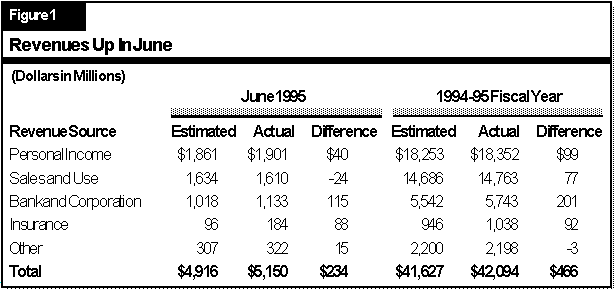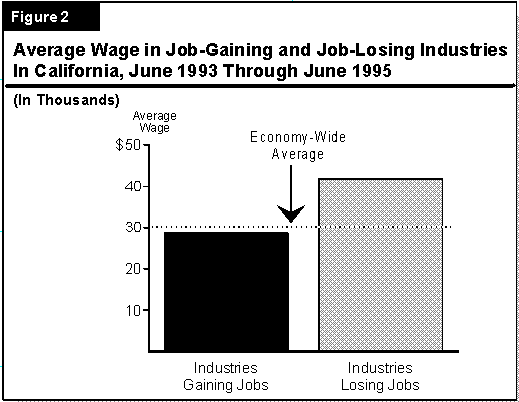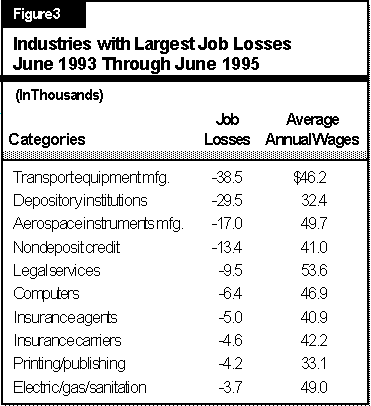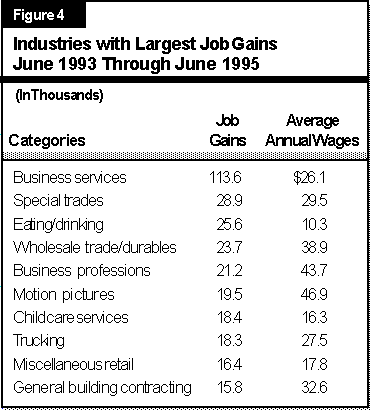

General Fund revenues exceeded the May Revision budget projection for the second month in a row during June. Total collections were up $234 million from the forecast, bringing cumulative 1994-95 cash receipts to $466 million above estimates (see Figure 1). About $59 million of the June increase is related to refunds of insurance and sales taxes which were expected to be made in June, but which now are anticipated to occur in early 1995-96. These refunds will be accrued to 1994-95, leaving revenues during the year up $407 million from the May Revision.

An additional $61 million in insurance tax refunds that had been expected to occur in June will be made later this year, thereby reducing 1995-96 revenues.
Of the remaining 1994-95 increase, about $113 million is due to one-time audit collections and interfund transfers relating to the bank and corporation tax, and the balance is from ongoing sources.
The revenue gain is encouraging not only from the standpoint of the budget, but also because of its implications for the economy. Tax receipts closely related to current economic activity--in particular personal income tax withholding and corporation tax prepayments--are up significantly in 1995 from the prior year, suggesting that employment, wages, and profits are continuing to expand in this state.
The implcations of the recent stronger-than-expected performance on 1995-96 collections, however, are unclear at this time given the uncertainties regarding the strength of the national and state economy during the next year.
Economic developments continue to suggest that Californias modest recovery remains on track, despite persistent weakness in the states housing market. Wage and salary employment continued to grow modestly in June, increasing by 16,500 jobs during the month. Most industry sectors showed at least small gains.
On a negative note, new home construction and sales failed to rebound significantly in May (the most recent month for which data are available) despite improving weather and declining interest rates. An improvement in the housing sector remains a key factor in the overall outlook for Californias economy during the next year.
The most recent round of base closures will result in the loss of about 23,000 civilian personnel jobs in California. The losses will have a significant impact on individual communities throughout the state. However, the closures will take place over several years. Thus, their impact on statewide economic growth in 1995 and early 1996 will be only modest.
There is now wide agreement that Californias economy has been in a modest recovery since mid-1993. Based on recent historical employment revisions, it appears that the state has added slightly more than 300,000 jobs during the past two years. Although the overall employment gains have been encouraging, a concern has emerged about the quality of the job growth; specifically, that the state is adding mostly low-paid, low-skilled jobs, while it continues to lose employment in high-paying industries.
The perception that California is replacing high-paying jobs with low-paying ones is only partly accurate. Our review of detailed employment and wage data suggests that California has indeed continued to lose jobs in high-paying industries over the past two years, largely reflecting continuing restructuring in the aerospace and financial sectors. However, the newly created jobs have not been uniformly low paying. Rather, they have been in a mixture of higher-paying and lower-paying occupations.
Figure 2 compares the average annual wages of the industries losing jobs to those adding jobs over the past two years. It shows that the average wage of all industries losing jobs is about $42,000, which is significantly above the economy-wide average of about $30,000 per year. The average wage of all newly created jobs is nearly $29,000, or slightly less than the economy-wide average.

Figure 3 shows the ten industries with the largest job losses between mid-1993 and mid-1995. It indicates that losses have been concentrated in high-paying industries such as transportation equipment (which includes producers of aircraft and missiles), aerospace instruments, legal services, financial services, and computers.

Figure 4 shows the ten industries with the largest job gains over the past two years. It indicates that many of the newly created jobs have been in lower-paying sectors, such as eating and drinking, retail trade, and child-care. However, a significant number have also been in high-wage sectors such as wholesale trade--which encompasses import and export businesses--motion pictures, and business professions. Smaller gains have also occurred in high-paying industries such as electronic components, software development and bio-technology.
